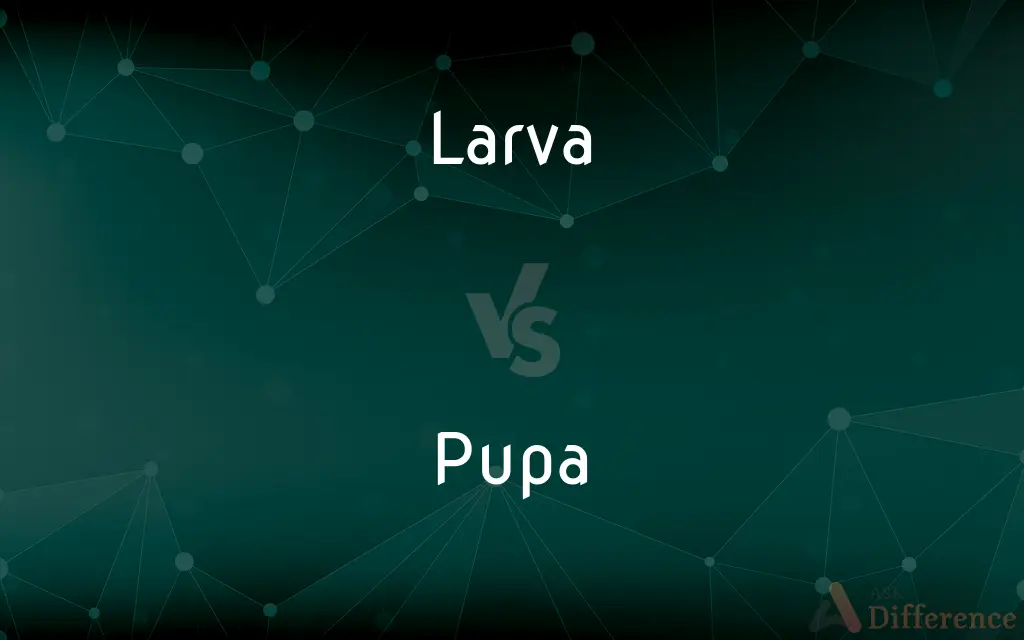Larva vs. Pupa — What's the Difference?
Edited by Tayyaba Rehman — By Maham Liaqat — Updated on March 21, 2024
Larva represents an early developmental stage in many animals, focusing on growth; pupa is a transitional stage, often immobile, leading to metamorphosis.

Difference Between Larva and Pupa
Table of Contents
ADVERTISEMENT
Key Differences
Larvae are the early stage of development in many animals, particularly insects, following hatching from the egg. This stage is characterized by significant growth and development, often appearing very different from the adult form. In contrast, the pupa is a subsequent stage in the life cycle of certain insects, representing a period of transformation, where the organism is typically encased and immobile, undergoing metamorphosis into its adult form.
While larvae are generally mobile and spend much of their time feeding to support their rapid growth, pupae are often inactive, with the critical biological processes occurring internally. This distinction highlights the primary focus of each stage: growth and feeding for larvae, transformation and development for pupae.
The physical appearance between these two stages is usually quite distinct. Larvae often have a worm-like appearance and are equipped with structures suited for feeding and sometimes defense. Pupae, on the other hand, are typically encased in a cocoon or chrysalis and show no external signs of the dramatic changes happening inside.
The duration of the larval and pupal stages can vary widely among species, influenced by environmental conditions and specific biological needs. The larval stage is typically longer, allowing time for significant growth, whereas the pupal stage is a finite period during which the larva transforms into an adult.
Both larval and pupal stages are crucial for the life cycle of insects and some other animals, facilitating significant transformations in structure, function, and habitat. The transition from larva to pupa is a key development phase, leading to the emergence of the adult form, ready for reproduction and dispersal.
ADVERTISEMENT
Comparison Chart
Primary Function
Growth and feeding
Transformation and development
Mobility
Generally mobile
Typically immobile, encased
Appearance
Often worm-like, adapted for feeding
Encased in a cocoon or chrysalis
Duration
Varies, often longer for growth
Finite, until metamorphosis completes
Role in Life Cycle
Early developmental stage
Transitional stage before becoming an adult
Compare with Definitions
Larva
Usually mobile and equipped for feeding, often looking different from the adult.
Mosquito larvae, known as wrigglers, live in water and feed on organic matter.
Pupa
Often immobile and encased, with internal changes not visible externally.
The pupa of a moth may be encased in a silk cocoon, undergoing transformation inside.
Larva
An early, often feeding stage in the development of many animals, particularly insects.
The caterpillar is the larval stage of a butterfly, focusing on eating and growing.
Pupa
To undergo metamorphosis, reorganizing the larval body into an adult form.
Inside the pupa, the structures of the larva rearrange to form the adult insect.
Larva
To grow and prepare for the next stage of development.
The larva of a dragonfly spends months or even years growing before becoming a pupa.
Pupa
A stage in certain animals' life cycle where metamorphosis from larva to adult occurs.
The chrysalis is the pupal stage of butterflies, where the larva transforms into an adult.
Larva
Undergoes significant growth and sometimes molts several times.
The beetle larva molts multiple times as it grows, shedding its exoskeleton.
Pupa
Emerges as a fully developed adult, ready for reproduction.
The adult butterfly emerges from the chrysalis, ready to mate and lay eggs.
Larva
Transitions into the pupal stage, where it will undergo metamorphosis.
After reaching a certain size, the larva forms a pupa, beginning its transformation.
Pupa
No feeding occurs; energy is focused on internal development.
The fly pupa remains inactive as it develops wings and other adult features.
Larva
A larva (plural larvae ) is a distinct juvenile form many animals undergo before metamorphosis into adults. Animals with indirect development such as insects, amphibians, or cnidarians typically have a larval phase of their life cycle.
Pupa
A pupa (Latin: pupa, "doll"; plural: pupae) is the life stage of some insects undergoing transformation between immature and mature stages. Insects that go through a pupal stage are holometabolous: they go through four distinct stages in their life cycle, the stages thereof being egg, larva, pupa, and imago.
Larva
The newly hatched, wingless, often wormlike form of many insects, developing into a pupa in species that undergo complete metamorphosis.
Pupa
An insect in the nonfeeding stage between the larva and adult, during which it typically undergoes complete transformation within a protective cocoon or hardened case. Only insects that undergo complete metamorphosis have pupal stages.
Larva
The six-legged immature form of a tick or mite.
Pupa
An insect in the development stage between larva and adult.
Larva
The newly hatched, earliest form of any of various animals that undergo metamorphosis, differing markedly in appearance from the adult.
Pupa
Any insect in that stage of its metamorphosis which usually immediately precedes the adult, or imago, stage.
Larva
Roman Mythology A malevolent spirit of the dead.
Pupa
A genus of air-breathing land snails having an elongated spiral shell.
Larva
An early stage of growth for some insects and amphibians, in which after hatching from their egg, insects are wingless and resemble a caterpillar or grub, and amphibians lack limbs and resemble fish.
Pupa
An insect in the inactive stage of development (when it is not feeding) intermediate between larva and adult
Larva
An animal in the aforementioned stage.
Larva
A form of a recently born or hatched animal that is quite different from its adult stage.
Larva
(figurative) A preliminary stage of someone or something, before it has fully matured, especially a time of growth rather than one of performance.
Larva
Any young insect from the time that it hatches from the egg until it becomes a pupa, or chrysalis. During this time it usually molts several times, and may change its form or color each time. The larvæ of many insects are much like the adults in form and habits, but have no trace of wings, the rudimentary wings appearing only in the pupa stage. In other groups of insects the larvæ are totally unlike the parents in structure and habits, and are called caterpillars, grubs, maggots, etc.
Larva
The early, immature form of any animal when more or less of a metamorphosis takes place, before the assumption of the mature shape.
Larva
The immature free-living form of most invertebrates and amphibians and fish which at hatching from the egg is fundamentally unlike its parent and must metamorphose
Common Curiosities
How does a larva turn into a pupa?
The larva undergoes significant hormonal changes that trigger the formation of the pupal casing and begin metamorphosis.
Can all insects form a pupa?
Not all insects have a pupal stage; it's typical of holometabolous insects undergoing complete metamorphosis.
Why don't pupae eat?
Pupae are focused on internal development and metamorphosis, using stored energy from the larval stage.
Is a cocoon the same as a pupa?
A cocoon is a protective casing spun by some larvae around the pupa for protection during metamorphosis.
How long does the pupal stage last?
The duration varies among species and environmental conditions but is finite, ending with the emergence of the adult.
Do larvae resemble their adult form?
Larvae often look quite different from the adult form, with significant changes occurring during metamorphosis.
Can the larval stage affect the adult form?
Yes, factors like nutrition and environmental stress during the larval stage can influence the characteristics of the adult.
Are pupae vulnerable to predators?
Yes, despite protective mechanisms like cocoons, pupae can be preyed upon due to their immobility.
Can humans influence the larval and pupal stages of insects?
Yes, through practices like breeding, habitat management, and pest control.
What is the primary purpose of the larval stage?
The larval stage is primarily for growth and feeding, preparing the organism for later transformation.
How do temperature and humidity affect the pupal stage?
They can significantly influence the duration and success of metamorphosis.
What triggers the transition from larva to pupa?
Environmental cues and developmental readiness trigger hormonal changes leading to pupation.
What happens inside a pupa?
The larval body is reorganized, and adult structures develop, replacing larval features.
How do scientists study larval and pupal stages?
Through observation, experimentation, and various analytical techniques to understand development and metamorphosis.
What role do larval and pupal stages play in ecosystems?
They are crucial for nutrient cycling, food webs, and the reproduction of many species.
Share Your Discovery

Previous Comparison
Arrange vs. Order
Next Comparison
Motto vs. SloganAuthor Spotlight
Written by
Maham LiaqatEdited by
Tayyaba RehmanTayyaba Rehman is a distinguished writer, currently serving as a primary contributor to askdifference.com. As a researcher in semantics and etymology, Tayyaba's passion for the complexity of languages and their distinctions has found a perfect home on the platform. Tayyaba delves into the intricacies of language, distinguishing between commonly confused words and phrases, thereby providing clarity for readers worldwide.
















































